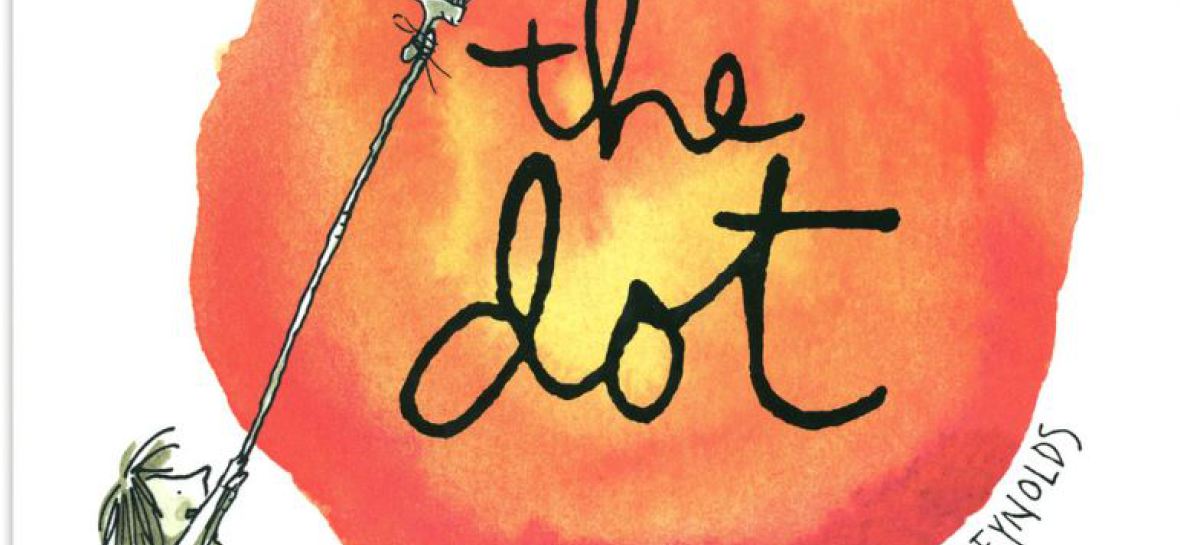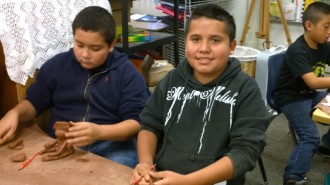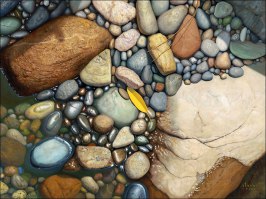

Moon Jumpers Third Graders' Cafe
C...Creating
Enduring Understanding: Artists and designers shape artistic investigations, following or breaking with traditions in pursuit of creative artmaking goals.
- See more at: http://nationalartsstandards.org/customize-handbook
Apply knowledge of available resources, tools, and technologies to investigate personal ideas through the art-making process. - See more at: http://nationalartsstandards.org/customize-handbook
Skills, Processes, Materials, and Tools
- 2.1 Explore ideas for art in a personal sketchbook.
- 2.2 Mix and apply tempera paints to create tints, shades, and neutral colors.
Communication and Expression Through Original Works of Art
- 2.3 Paint or draw a landscape, seascape, or cityscape that shows the illusion of space.
- 2.4 Create a work of art based on the observation of objects and scenes in daily life, emphasizing value changes.
- 2.5 Create an imaginative clay sculpture based on an organic form.
- 2.6 Create an original work of art emphasizing rhythm and movement, using a selected printing process.
A...Articulating Artistic Process
- See more at: http://nationalartsstandards.org/customize-handbook
Develop Perceptual Skills and Visual Arts Vocabulary
- 1.1 Perceive and describe rhythm and movement in works of art and in the environment.
- 1.2 Describe how artists use tints and shades in painting.
- 1.3 Identify and describe how foreground, middle ground, and background are used to create the illusion of space.
- 1.4 Compare and contrast two works of art made by the use of different art tools and media (e.g., watercolor, tempera, computer).
Analyze Art Elements and Principles of Design
- 1.5 Identify and describe elements of art in works of art, emphasizing line, color, shape/form, texture, space, and valu
F...Finding Connections
- See more at: http://nationalartsstandards.org/customize-handbook
Role and Development of the Visual Arts
- 3.1 Compare and describe various works of art that have a similar theme and were created at different time periods.
- 3.2 Identify artists from his or her own community, county, or state and discuss local or regional art traditions.
- 3.3 Distinguish and describe representational, abstract, and nonrepresentational works of art.
Diversity of the Visual Arts
- 3.4 Identify and describe objects of art from different parts of the world observed in visits to a museum or gallery (e.g., puppets, masks, containers).
- 3.5 Write about a work of art that reflects a student's own cultural background.
-
Connections and Applications
- 5.1 Describe how costumes contribute to the meaning of a dance.
- 5.2 Write a poem or story inspired by their own works of art.
-
Visual Literacy
- 5.3 Look at images in figurative works of art and predict what might happen next, telling what clues in the work support their ideas.
-
Careers and Career-Related Skills
- 5.4 Describe how artists (e.g., architects, book illustrators, muralists, industrial designers) have affected people's lives.
E...Engaging with the Art
- See more at: http://nationalartsstandards.org/customize-handbook
Derive Meaning
- 4.1 Compare and contrast selected works of art and describe them, using appropriate vocabulary of art.
Make Informed Judgments
- 4.2 Identify successful and less successful compositional and expressive qualities of their own works of art and describe what might be done to improve them.
- 4.3 Select an artist's work and, using appropriate vocabulary of art, explain its successful compositional and communicative qualities.
I Can Common Core Revised to work with Art
I can effectively participate in discussions. SL.3.1
I can come to discussions prepared to share my ideas. SL.3.1
I can follow appropriate rules for discussions, such as taking my turn. SL.3.1
I can ask questions to help me understand discussions and stay on topic. SL.3.1
I can explain my own thinking and ideas after a discussion. SL.3.1
I can figure out the main idea and details of what I see and hear. SL.3.2
I can ask and answer questions about information I hear from another speaker.
SL.3.2
I Can Share What I Know
I can report on a topic or tell a story with correct and appropriate facts. SL.3.4
I can speak clearly and at a good pace. SL.3.4
I can create engaging audio recordings to show fluency in my reading. SL.3.5
I can create visual displays to help others understand what I am sharing. SL.3.5
I can speak in complete sentences to make what
I am sharing more clear to others. SL.3.6
Artful Teaching
Mrs. Schellenberg & Young Artists
Ralph Waldo Emerson's Poem: Success- to leave the world a bit better, whether by a healthy child, a garden patch or a redeemed social condition; To know even one life breathed easier because of you.
Thank you AT&T
We used the wiring for our artful galimotos





